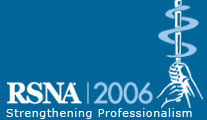
Abstract Archives of the RSNA, 2006
SSC08-05
Diagnostic Accuracy of Dual Source CT Coronary Angiography in Patients Referred for Conventional Angiography
Scientific Papers
Presented on November 27, 2006
Presented as part of SSC08: ISP: Cardiac (CT)
Annick Carine Weustink MD, Presenter: Nothing to Disclose
Nico R Mollet MD, Abstract Co-Author: Nothing to Disclose
Bob Meijboom MD, Abstract Co-Author: Nothing to Disclose
Bernd M. Ohnesorge PhD, Abstract Co-Author: Employee, Siemens AG, Forcheim, Germany
Gabriel Paul Krestin MD, PhD, Abstract Co-Author: Nothing to Disclose
Pim J. De Feyter MD,PhD, Abstract Co-Author: Nothing to Disclose
To prospectively evaluate the diagnostic accuracy of Dual-Source Computed Tomography (DSCT) coronary angiography to detect significant stenoses (defined as ≥50% lumen diameter reduction) in patients referred for conventional coronary angiography without the use of pre-scan beta-blockers.
We studied 30 patients (24 men; mean age 66±13.2) with atypical chest pain, stable or unstable angina pectoris, non-ST-segment elevation myocardial infarction, scheduled for diagnostic conventional coronary angiography. All patients were scanned with a DSCT scanner (Somatom Definition, Siemens Medical Solutions Forcheim, Germany) equipped with an improved temporal resolution of 83 ms as compared to previous CT scanner generations. Only patients able to breath hold for 10 s and in sinus rhythm were included. Patients with contra-indications to Iodinated contrast material were excluded. No ß-blockers were administered prior to the scan. A bolus of 70 ml of contrast material with a high iodine concentration was injected with a flow rate of 5 ml/s followed by a saline chaser of 50 ml at 5 ml/s. Mean scan time was 7.8±1.9 seconds. Pitch varied between 0.2 and 0.5. Mean heart rate was 73±16. The CT angiograms were analyzed by 2 observers blinded to the results of invasive coronary angiography, which was used as the standard of reference.
Conventional coronary angiography demonstrated the absence of significant disease in 20% (6 of 30), single vessel disease in 27% (8 of 30), and multi-vessel disease in 53% (16 of 30) of patients. Sensitivity of CT coronary angiography for detecting significant stenoses on a segment-based analysis was 92%, specificity was 96%, and positive and negative predictive values were 73% and 99% respectively.
Our preliminary results show that the diagnostic accuracy of DSCT coronary angiography for the detection of significant lesions in patients referred for conventional angiography is high, even in patients with fast heart rates.
Improved diagnostic accuracy of CT coronary angiography in high heart rates reduces the need for pre-scan ß-blockers and makes CT a more robust technique to non-invasively detect significant stenoses.
Weustink, A,
Mollet, N,
Meijboom, B,
Ohnesorge, B,
Krestin, G,
De Feyter, P,
Diagnostic Accuracy of Dual Source CT Coronary Angiography in Patients Referred for Conventional Angiography. Radiological Society of North America 2006 Scientific Assembly and Annual Meeting, November 26 - December 1, 2006 ,Chicago IL.
http://archive.rsna.org/2006/4440067.html

